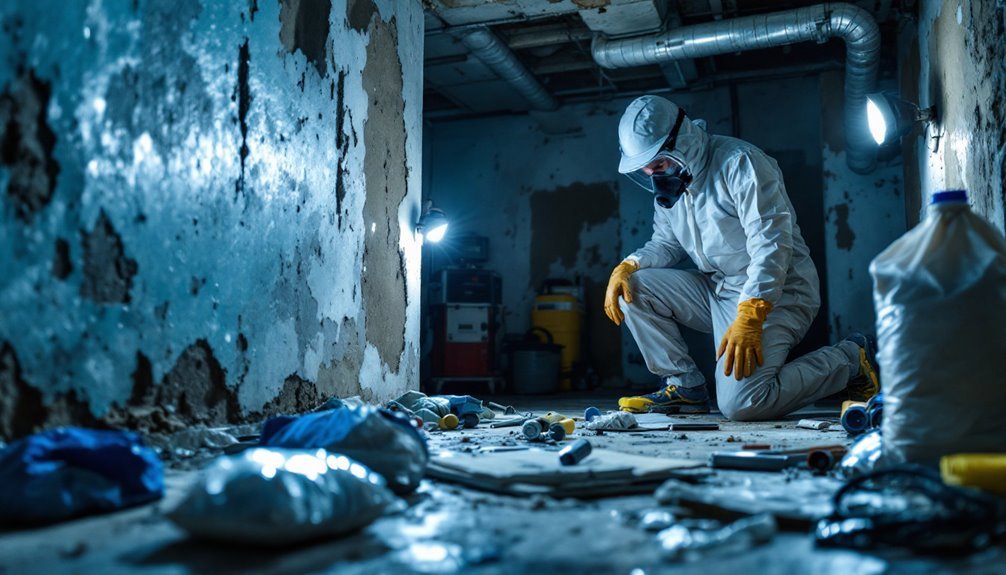To safely abate asbestos, start with a thorough inspection of your premises to identify asbestos-containing materials (ACMs). Hire a certified inspector for accurate assessment and documentation. Next, collect samples for laboratory testing to confirm asbestos presence. If asbestos is detected, set up a controlled work area using plastic sheeting, and always wear proper personal protective equipment (PPE). Wet materials before removal to minimize dust, and use hand tools to limit fiber release. After removal, conduct a final air quality test and clean the area with HEPA vacuums. There's more to uncover about each phase of this critical process.
Understanding Asbestos Risks

Recognizing the dangers of asbestos is vital for anyone involved in construction, renovation, or property management. Asbestos exposure poses significant health risks, including lung cancer, mesothelioma, and asbestosis. These conditions arise when asbestos fibers become airborne and are inhaled, leading to long-term respiratory issues.
It's important to understand that the risks associated with asbestos aren't limited to immediate exposure. Even minimal contact can lead to serious health impacts over time. If you're handling materials that may contain asbestos, you must prioritize safety measures, including using appropriate personal protective equipment (PPE) and ensuring proper ventilation in work areas.
Before beginning any project, assess your environment for potential asbestos-containing materials (ACMs). Be aware that aging buildings, especially those constructed before the 1980s, are more likely to contain these hazardous materials. Ignoring asbestos risks can result in not only legal repercussions but significant health challenges for you and your team.
Ultimately, your awareness and proactive approach can make a notable difference in mitigating the dangers of asbestos exposure, allowing you to maintain a safer working environment while safeguarding your health and the health of others.
Initial Inspection Process
Begin the initial inspection process by thoroughly evaluating the premises for any potential asbestos-containing materials (ACMs). You'll want to use appropriate inspection techniques, such as visual assessments and historical research of building materials, to identify likely sources of asbestos. Pay close attention to areas like insulation, floor tiles, and ceiling materials commonly associated with ACMs.
Confirm that you engage a certified inspector, as their qualifications are vital for accurate identification. An inspector should possess relevant training in asbestos management and have experience in handling related inspections. They should additionally be familiar with local regulations and guidelines on asbestos safety.
During the inspection, document your findings meticulously. Take photographs and make detailed notes about the locations and conditions of suspected ACMs. This documentation is fundamental for planning the next steps in the abatement process. Remember, a thorough inspection not only protects your health but also guarantees compliance with legal requirements.
Testing for Asbestos

After completing the initial inspection process and identifying suspected asbestos-containing materials (ACMs), the next step involves testing these materials to confirm their asbestos content. Asbestos testing is essential for guaranteeing safety during any renovation or demolition project. You'll need to select appropriate sampling methods to accurately assess the presence of asbestos.
Here's what you should consider during the testing process:
- Choose a Qualified Professional: Always hire a certified asbestos inspector or testing lab.
- Collect Samples Safely: Use proper protective equipment and follow guidelines to minimize exposure.
- Select Sampling Methods: Different methods, such as bulk sampling or air sampling, can be employed based on the situation.
- Analyze Results Promptly: Send samples to an accredited laboratory for timely results, and review them carefully.
Once you receive the results, you'll know whether asbestos is present and in what concentration. This information is essential for determining the next steps in the abatement process. By adhering to these guidelines, you can guarantee a thorough and safe testing phase that lays the foundation for effective asbestos management.
Safe Removal Procedures
How can you guarantee a safe and effective asbestos removal process? First, make sure you've established a controlled work area. Use plastic sheeting to seal off the area, preventing asbestos fibers from escaping. Next, don't forget to wear appropriate personal protective equipment (PPE), including respirators, gloves, and disposable coveralls. This is essential in adhering to safety protocols.
Before you start the removal, wet the asbestos material to minimize dust. Use a spray bottle or a garden sprayer, but avoid soaking it too much, as you don't want to compromise the material's integrity. Carefully cut or scrape the asbestos with hand tools rather than power tools to limit the release of fibers.
As you remove the material, place it directly into labeled, leak-proof bags. This guarantees proper containment and prevents any potential exposure. Throughout this process, maintain clear communication with your team, and establish a safety monitoring system.
Finally, always follow federal and local regulations regarding asbestos removal. By adhering to these detailed procedures and safety protocols, you'll greatly reduce the risk associated with asbestos removal, providing a safer environment for everyone involved.
Post-Abatement Cleanup

Once the asbestos has been safely removed, a thorough post-abatement cleanup is vital to guarantee no remnants pose a risk. This phase is significant in confirming that the area is not only clean but likewise safe for reoccupation. You must follow post-abatement best practices during this process.
Begin by implementing the following steps:
- Visual Inspection: Check the area for any visible debris or leftover materials.
- Air Monitoring: Conduct air quality tests to confirm no airborne asbestos fibers remain.
- Debris Disposal: Verify all debris is properly sealed and disposed of in accordance with local regulations.
- Final Cleaning: Use HEPA vacuums and wet wiping techniques to eliminate any potential contaminants.
Conclusion
In the journey of asbestos abatement, think of yourself as a skilled navigator steering through treacherous waters. By understanding the risks, conducting thorough inspections, and following safe removal procedures, you're not just ensuring safety but additionally reclaiming a healthier environment. Post-abatement cleanup is your final port of call, clearing away the remnants of danger. With each step, you're charting a course toward a more secure future, safeguarding yourself and others from the hidden threats of asbestos.
